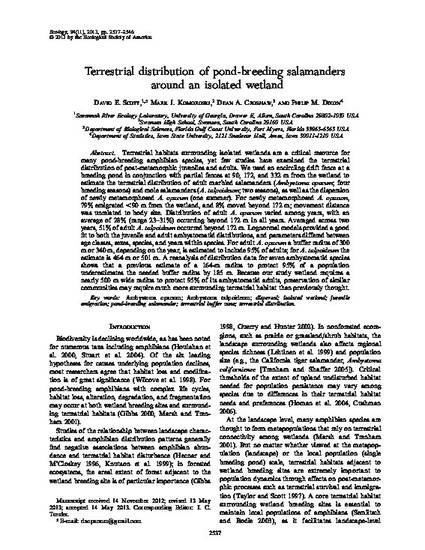
Terrestrial habitats surrounding isolated wetlands are a critical resource for many pond-breeding amphibian species, yet few studies have examined the terrestrial distribution of post-metamorphic juveniles and adults. We used an encircling drift fence at a breeding pond in conjunction with partial fences at 90, 172, and 332 m from the wetland to estimate the terrestrial distribution of adult marbled salamanders (Ambystoma opacum; four breeding seasons) and mole salamanders (A. talpoideum; two seasons), as well as the dispersion of newly metamorphosed A. opacum (one summer). For newly metamorphosed A. opacum, 79% emigrated wetland, and 8% moved beyond 172 m; movement distance was unrelated to body size. Distribution of adult A. opacum varied among years, with an average of 28% (range 23–31%) occurring beyond 172 m in all years. Averaged across two years, 51% of adult A. talpoideum occurred beyond 172 m. Lognormal models provided a good fit to both the juvenile and adult ambystomatid distributions, and parameters differed between age classes, sexes, species, and years within species. For adult A. opacum a buffer radius of 300 m or 340 m, depending on the year, is estimated to include 95% of adults; for A. talpoideum the estimate is 464 m or 501 m. A reanalysis of distribution data for seven ambystomatid species shows that a previous estimate of a 164-m radius to protect 95% of a population underestimates the needed buffer radius by 185 m. Because our study wetland requires a nearly 500 m wide radius to protect 95% of its ambystomatid adults, preservation of similar communities may require much more surrounding terrestrial habitat than previously thought.
Available at: http://works.bepress.com/philip-dixon/11/

This is an article from Ecology 94 (2013): 2537, doi:10.1890/12-1999.1. Posted with permission.